Get started quickly, see results immediately, no code needed.
Top 25+ Facilities Management Software Changing the Game in 2024
Embrace the power of streamlined efficiency and optimized operations with facilities management software!
From enhancing asset performance to revolutionizing maintenance practices, we will take you through the 27 top-notch tools designed to transform workplaces. Discover the must-have features that empower businesses to thrive and facilities to shine!
At the end we’ll walk you through:
- What is facilities management software?
- Benefits of facilities management software
- Key features of facilities management software
Process Street

Process Street serves as comprehensive facility management software by organizing maintenance schedules, streamlining work orders, and tracking inventory. Its checklist-based system ensures consistent workflows for inspections, repairs, and facility upkeep. With task automation and reporting features, it optimizes efficiency, reduces downtime, and enhances overall facility operations.
Key features:
- Checklist automation: Create and automate dynamic checklists for recurring processes.
- Conditional logic: Customize workflows with conditional logic based on responses.
- Collaborative workflows: Facilitate team collaboration on tasks and processes.
- Integration capabilities: Seamlessly integrate with tons of apps and tools.
- Task assignment: Assign and track responsibilities within processes.
- Data collection: Gather and store data through forms within checklists.
- Reporting and analytics: Generate insights with analytics on process performance.
- Version control: Maintain and track versions of checklists for auditing.
- API access: Connect with other applications through APIs.
- Document storage: Attach and manage documents relevant to processes.
Pros:
- Intuitive interface makes it user-friendly.
- Offers secure data handling and storage.
- It has a mobile application.
- Custom automated workflows can be made with AI.
- It has lots of premade workflow templates to choose from.
Cons:
- There is no free plan.
Pricing: Process Street pricing page.
Facilio

Facilio revolutionizes real estate operations with its IoT-enabled platform by unifying building management functions. Offering predictive maintenance and energy optimization, it streamlines facility performance. Facilio’s AI-driven insights empower data-driven decisions, enhancing operational efficiency and tenant comfort. Its scalable and adaptive solutions redefine modern property management for sustainable and smart buildings.
Key features:
- IoT integration: Utilizes IoT devices for data collection and monitoring.
- Unified building management: Consolidates various building functions into a single platform.
- Predictive maintenance: Forecasts maintenance needs to prevent breakdowns.
- Energy optimization: Focuses on improving energy efficiency and consumption.
- Tenant comfort management: Enhances tenant experience through optimized facilities.
Pros:
- Uses AI for data analysis and decision-making support.
- Ensures adherence to regulatory standards.
- Tracks and reports on sustainability initiatives and goals.
- Allows monitoring and control from anywhere.
Cons:
- The process of making work orders is long.
- It takes time to learn and implement.
Pricing: Facilio pricing request.
Procore

Procore is a cloud-based construction management platform that centralizes project data, streamlines communication, and enhances collaboration across teams. It offers tools for project management, scheduling, document control, and financial management. Procore’s mobile accessibility ensures real-time updates, boosting efficiency and transparency in construction projects.
Key features:
- Scheduling: Tools to create, manage, and update project schedules, ensuring tasks are completed on time.
- Document management: Secure storage and sharing of project documents, drawings, and specifications.
- Financial management: Tracking and managing project budgets, costs, and change orders for better financial control.
- Quality and safety: Modules for tracking safety incidents, inspections, and quality control measures to maintain compliance.
- Resource management: Tools for managing resources, including labor, equipment, and materials.
Pros:
- Streamlined bidding process, allowing for easy communication with subcontractors and suppliers.
- Mobile app for on-site access, enabling real-time updates, photo documentation, and progress tracking.
- Access to data and analytics for performance tracking, decision-making, and improving future projects.
Cons:
- Customization options might be limited for specific project needs, leading to potential constraints in tailoring the platform.
Pricing: Procore pricing page.
Corrigo

Corrigo is a facilities management platform streamlining maintenance operations. It offers tools for work order management, asset tracking, and vendor management. With mobile accessibility, it enables on-the-go task management, improving efficiency. Corrigo’s analytics provide insights for informed decision-making, optimizing facility maintenance and performance.
Key features:
- Work order management: Efficiently create, assign, and track work orders, streamlining maintenance tasks and requests.
- Asset tracking: Maintain a detailed inventory of facility assets, monitoring their performance and maintenance needs.
- Vendor management: Coordinate and manage vendor relationships, ensuring timely service delivery and compliance.
- Mobile accessibility: Accessible via mobile devices for on-the-go management, facilitating quick responses to maintenance needs.
- Preventive maintenance: Schedule and automate routine maintenance tasks to prevent issues and prolong asset lifespan.
Pros:
- Helps ensure adherence to industry regulations and compliance standards.
- Integrates with other systems or software for seamless data exchange and enhanced workflow efficiency.
- Provides a platform for customers to submit maintenance requests and track their status.
- Manages service requests from submission to resolution.
Cons:
- They don’t offer a free trial.
- Users have complained about the search function being poor.
Pricing: Corrigo contact page.
TOPdesk
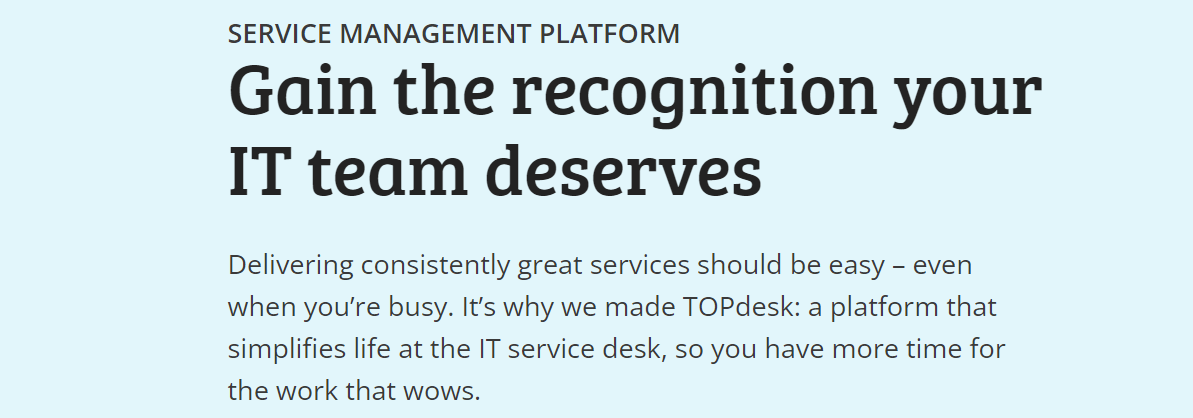
TOPdesk serves as comprehensive facility management software by centralizing maintenance requests, managing work orders, and optimizing asset management. It allows for seamless ticketing, scheduling preventive maintenance, and tracking assets.
Key features:
- Incident and request management: Centralized platform for managing maintenance requests, incidents, and service desk operations.
- Asset management: Track and manage assets, including equipment, facilities, and inventory, streamlining maintenance and replacements.
- Scheduled maintenance: Plan and schedule preventive maintenance tasks, ensuring equipment longevity and reducing downtime.
- Resource planning: Efficiently allocate resources, manage workloads, and schedule tasks for optimal facility operations.
- Self-service portal: Empower users to submit maintenance requests, track progress, and access information through a user-friendly portal.
Pros:
- Monitors service level agreements (SLAs).
- Creates and accesses a repository of information.
- Generates reports and analyzes data to identify trends, optimize workflows, and make data-driven decisions.
Cons:
- It has occasional performance issues.
Pricing: TOPdesk pricing page.
TheWorxHub
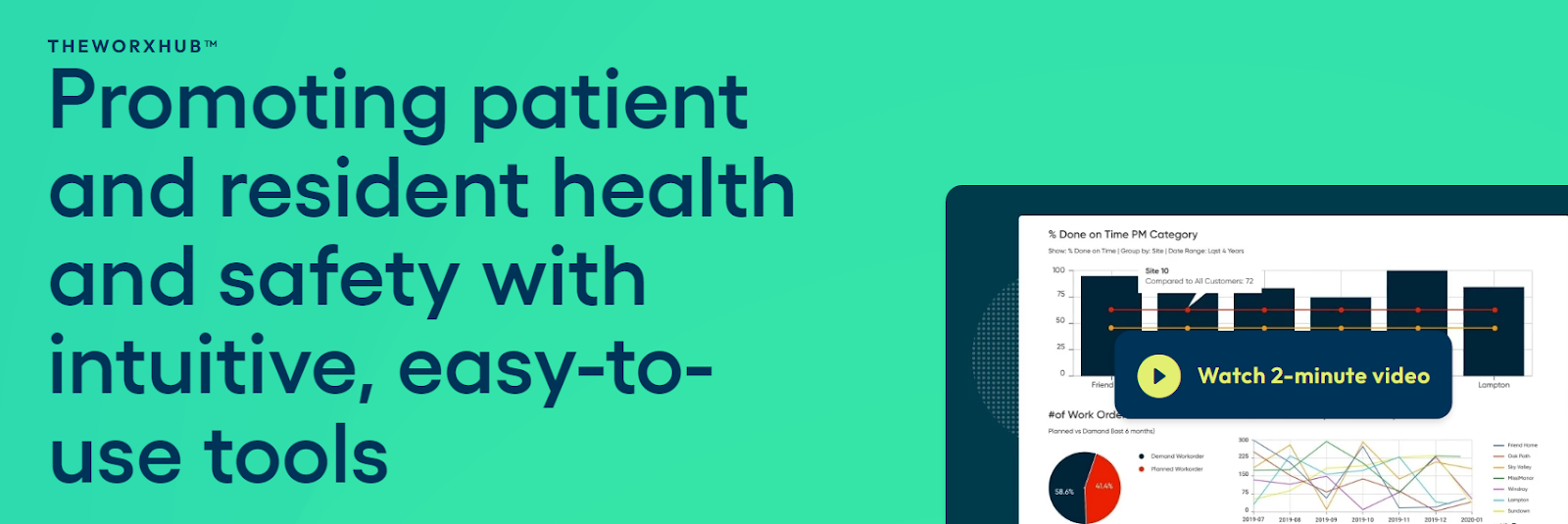
TheWorxHub streamlines facility management by offering a comprehensive platform designed to enhance operational efficiency. It focuses on optimizing workflows, fostering collaboration, and providing insights for informed decision-making, catering to the diverse needs of facility managers within the healthcare industry.
Key features:
- Work order management: Centralizes work orders and facilitates communication among team members.
- Inventory management: Comprehensive tools for tracking and managing inventory.
- Preventative maintenance: Schedule and automate routine maintenance tasks to prevent issues and prolong asset lifespan.
- Reporting and analytics: Access to data and analytics for performance tracking, decision-making, and improving future projects.
Pros:
- Offers tons of customization options.
- Provides lots of storage space and ways to organize data.
- Has a shareable calendar to keep stakeholders informed.
Cons:
- It takes time to set up and roll out.
Pricing: TheWorxHub demo request.
Hippo CMMS
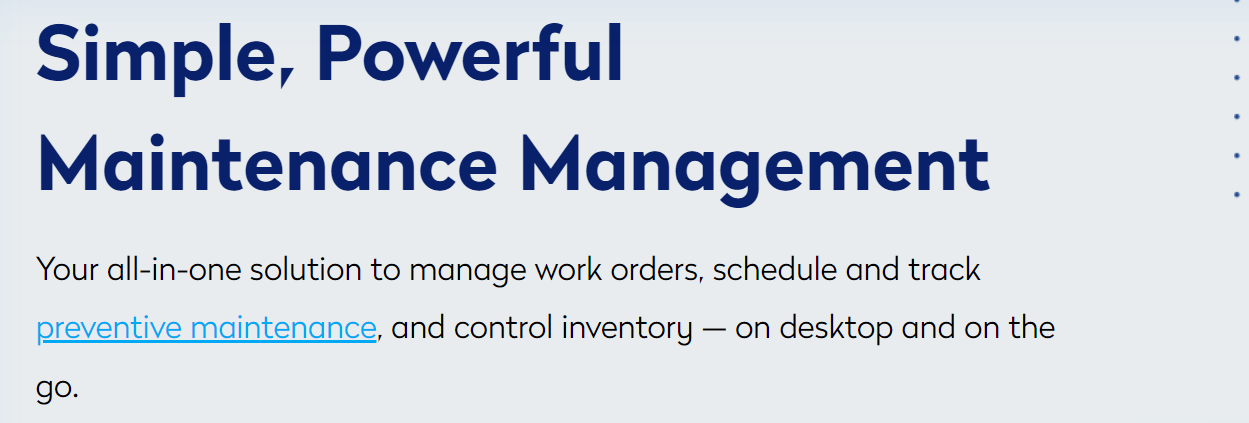
Hippo CMMS revolutionizes maintenance management by offering a user-friendly, scalable solution. It empowers businesses to streamline operations, optimize asset performance, and ensure regulatory compliance. Through its intuitive platform, it enhances productivity, minimizes downtime, and fosters a proactive approach to maintenance across industries.
Key features:
- Work order management: Creation, assignment, and tracking of work orders for maintenance tasks.
- Preventive maintenance: Scheduling and automating routine maintenance tasks to avoid equipment breakdowns.
- Asset management: Tracking and managing equipment, machinery, and facilities.
- Vendor management: Managing relationships with external service providers and vendors.
- Facility scheduling: Scheduling and coordinating maintenance activities for facilities.
Pros:
- Stores and organizes maintenance-related documents and manuals.
- Allows users to create personalized views and data visualization for better insights.
- Monitors and manages spare parts and supplies inventory.
- Generates reports on maintenance activities, asset performance, and costs.
Cons:
- Users have reported difficulty integrating with other software.
- There is no feature that allows users to make inventory requests.
Pricing: Hippo CMMS contact page.
Asset Panda

Asset Panda is a comprehensive asset tracking platform that simplifies inventory management. Renowned for its adaptability and robustness, it offers a seamless solution for businesses. With a focus on flexibility and customization, Asset Panda makes asset tracking and management across various industries super easy.
Key features:
- Asset tracking: Tracks and manages assets throughout their lifecycle.
- Customizable fields: Allows custom fields to adapt to unique asset information.
- Barcode scanning: Efficiently manages assets through barcode scanning.
- Maintenance management: Schedules and tracks asset maintenance tasks.
- Check-in/check-out: Tracks asset movement and usage history.
Pros:
- Helps businesses scale.
- Monitors asset locations across various sites.
- Provides insights into asset data and utilization.
- Highly customizable to fit unique asset tracking needs.
Cons:
- Extensive customization might be complex for some users.
- Pricing is only available upon request.
Pricing: Asset Panda pricing page.
Simpro

Simpro redefines field service management with its innovative solutions, empowering businesses to streamline operations and scale efficiently. It revolutionizes workflow automation, enabling seamless job tracking and enhancing customer experiences.
Key features:
- Fleet tracking: Monitors and manages vehicles and assets.
- Lead management: Tracks and nurtures potential customers throughout their journey.
- Site management: Oversees and coordinates various activities at any site, ensuring its smooth operation and functionality.
- Timesheets: Tracks timesheets for accurate time keeping.
Pros:
- They deliver excellent customer support.
- They offer an integration team to help new users get started.
- It’s easy to use.
Cons:
- The permissions settings don’t always work properly.
Pricing: Simpro pricing request.
Asset Essentials

Asset Essentials offers a comprehensive asset management solution, improving maintenance operations across industries. It empowers organizations for proactive maintenance, optimizing asset performance, and ensuring regulatory compliance.
Key features:
- Work order management: Assign work orders based on specific locations.
- Maintenance request portal: End users can request maintenance easily.
- Budget tracking: Offers a 360-degree view of operations, allowing for better budgeting.
- Preventive maintenance: Plan and schedule maintenance to help extend the life of physical assets.
Pros:
- Works really well for the manufacturing industry.
- The reporting feature is very robust.
- They walk new users through every step of the implementation process.
Cons:
- Users have reported difficulty understanding the metrics.
Pricing: Asset Essentials demo request.
SafetyCulture (formerly iAuditor)

SafetyCulture modernizes safety and quality inspections with its intuitive mobile platform. It empowers teams to conduct efficient audits, streamline reporting, and ensure compliance across industries. By facilitating real-time data collection and analysis, SafetyCulture promotes proactive risk management, driving safer workplaces and operational excellence.
Key features:
- Mobile inspections: Conduct inspections using mobile devices, facilitating on-site data collection.
- Media capture: Capture and attach images, annotations, or notes to inspection reports.
- Analytics and trends: Analyze inspection data to identify trends and areas for improvement.
- Actionable insights: Gain actionable insights from data to enhance safety and quality practices.
- Compliance monitoring: Ensure adherence to regulatory standards and compliance requirements.
Pros:
- Integrates with other systems for streamlined data flow and reporting.
- Facilitates team collaboration and communication for efficient inspections and resolutions.
- Users can build customizable checklists tailored to specific inspection needs.
Cons:
- Users have difficulty working with software updates.
Pricing: SafetyCulture pricing page.
ArcGIS
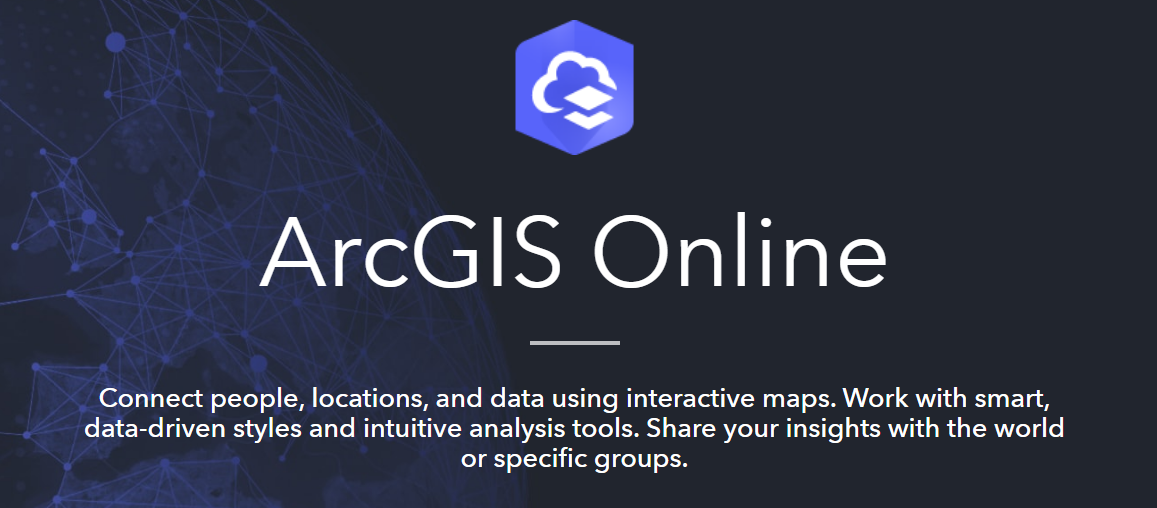
ArcGIS revolutionizes spatial analysis and mapping, offering a robust platform for geospatial data management. It empowers users across industries to visualize, analyze, and interpret data through maps, enabling informed decision-making. With its comprehensive tools and interactive capabilities, ArcGIS drives innovation and solves complex location-based challenges worldwide.
Key features:
- Mapping and visualization: Create interactive and detailed maps for spatial analysis.
- Spatial analysis: Perform complex geospatial analysis and modeling.
- Data management: Store, manage, and analyze geographic data efficiently.
- Geocoding and geolocation: Convert addresses to map coordinates and vice versa.
- Field data collection: Collect data in the field using mobile devices for real-time updates.
Pros:
- Creates interactive narratives combining maps, multimedia, and text.
- Visualizes data in 3D for better spatial understanding.
- Accesses specialized apps for specific industry needs, such as urban planning or environmental management.
- Analyzes data in real-time to support dynamic decision-making.
Cons:
- Users have had trouble installing it into their systems.
- The UI isn’t very intuitive.
Pricing: ArcGIS pricing page.
Maintenance Connection

Maintenance Connection offers a robust maintenance management platform, empowering businesses to streamline operations and optimize asset performance. With its user-friendly interface, it facilitates efficient work order management, preventive maintenance scheduling, and insightful reporting. The system promotes proactive maintenance strategies, driving operational efficiency and cost savings.
Key features:
- Work order management: Creation, assignment, and tracking of work orders.
- Preventive maintenance: Scheduling routine maintenance tasks for equipment and assets.
- Asset management: Tracking and managing equipment, facilities, and inventory.
- Inventory management: Monitoring and managing spare parts and supplies inventory.
- Reporting and analytics: Generating reports on maintenance activities, costs, and performance.
Pros:
- Manages relationships with external service providers and vendors.
- Schedules and coordinates maintenance activities for facilities.
- Allows users to personalize views and data visualization for insights.
- Stores and organizes maintenance-related documents and manuals.
Cons:
- Some users have reported occasional lost data.
- The archive folder doesn’t always work properly.
Pricing: Maintenance Connection pricing page.
Fiix

Fiix empowers businesses to optimize asset performance and streamline operations. It offers intuitive solutions for work order management, preventive maintenance, and insightful reporting. Fiix fosters proactive maintenance strategies, enhancing efficiency, reducing downtime, and driving cost-effective maintenance practices.
Key features:
- Inventory management: Monitoring and managing spare parts and supplies.
- Vendor management: Managing relationships with external service providers.
- Resource planning: Efficiently allocating resources and managing workloads.
- Integration capabilities: Seamless integration with other systems for data exchange.
- Customizable dashboards: Personalized views and data visualization for insights.
Pros:
- Allows for the creation, assignment, and tracking of work orders.
- Offers the scheduling of routine maintenance tasks for assets and equipment.
- Tracks and manages assets, inventory, and equipment history.
- Generates reports on maintenance activities, costs, and performance.
Cons:
- It takes time to get everything set up initially.
- Users have reported rude customer support.
Pricing: Fiix pricing page.
Maxpanda

Maxpanda modernizes maintenance management, offering businesses to optimize asset performance and streamline operations. It facilitates work order management, preventive maintenance scheduling, and comprehensive reporting, fostering proactive strategies for efficient maintenance practices across various industries.
Key features:
- Preventive maintenance: Scheduling routine maintenance tasks for assets and equipment.
- Asset management: Tracking and managing assets, inventory, and equipment history.
- Mobile accessibility: Access and manage maintenance tasks through mobile devices.
- Reporting and analytics: Generating reports on maintenance activities, costs, and performance.
- Inventory management: Monitoring and managing spare parts and supplies.
Pros:
- Manages relationships with external service providers.
- Allows users to track the progress of a request in real-time.
- It is easy to train staff to use it.
- Efficiently allocates resources and manages workloads.
Cons:
- You have to sign up for a free trial in order to get pricing information.
- Pages sometimes won’t load.
Pricing: Maxpanda pricing page.
ServiceChannel

ServiceChannel redefines facility management with its comprehensive platform, empowering businesses to streamline maintenance operations and vendor management. It facilitates efficient work order management, vendor communication, and data-driven insights. ServiceChannel drives efficiency, cost savings, and operational excellence across diverse industries.
Key features:
- Contractor sourcing: Finding and engaging contractors for specific services.
- Invoicing and payments: Managing invoicing and payment processes for services rendered.
- Compliance tracking: Monitoring regulatory and compliance standards for facilities.
- Asset management: Tracking and managing facility assets and equipment.
Pros:
- Schedules and dispatches tasks to maintenance teams or vendors.
- Manages vendor relationships, bids, and performance tracking.
- Offers customizable dashboards and analytics for better insights.
Cons:
- Some important features are not very intuitive.
Pricing: ServiceChannel demo request.
eMaint

eMaint offers a powerful CMMS solution giving businesses the ability to streamline workflows, manage assets, and optimize maintenance operations. Through preventive maintenance, insightful reporting, and seamless integrations, eMaint drives efficiency, reduces downtime, and enhances overall operational performance.
Key features:
- Assignment management: Track maintenance assignments.
- Facility asset management: Manages quality and quantity of facility assets.
- Resource planning: Efficiently allocates resources and manages workloads.
- Purchase order management: Creates, issues, tracks, and manages purchase orders.
Pros:
- They offer new users a dedicated implementation specialist.
- They have great customer support.
- It pulls useful data to create helpful charts.
Cons:
- Some features are complicated and require training.
Pricing: eMaint pricing page.
UpKeep

UpKeep empowers teams to streamline operations and optimize asset performance. Through its user-friendly interface, it facilitates work order management, preventive maintenance scheduling, and insightful reporting. UpKeep drives efficiency, reduces downtime, and enhances overall operational effectiveness.
Key features:
- Appointment scheduling: Facilitates the scheduling of appointments with clients and vendors.
- Labor cost reporting: Tracks employee hours and reports on pay.
- Historical reporting: Maintains and resorts on historical data.
- Performance metrics: Provides metrics on asset performance.
- Retail inventory management: Tracks quantity and location of inventory for retail.
Pros:
- Keeps all facility management information stored in one place.
- Keeps track of work orders.
- Aids in monitoring assets.
- There’s a portal for tenants to submit requests.
Cons:
- It can be tricky and take time to learn.
Pricing: UpKeep pricing plans.
FMX
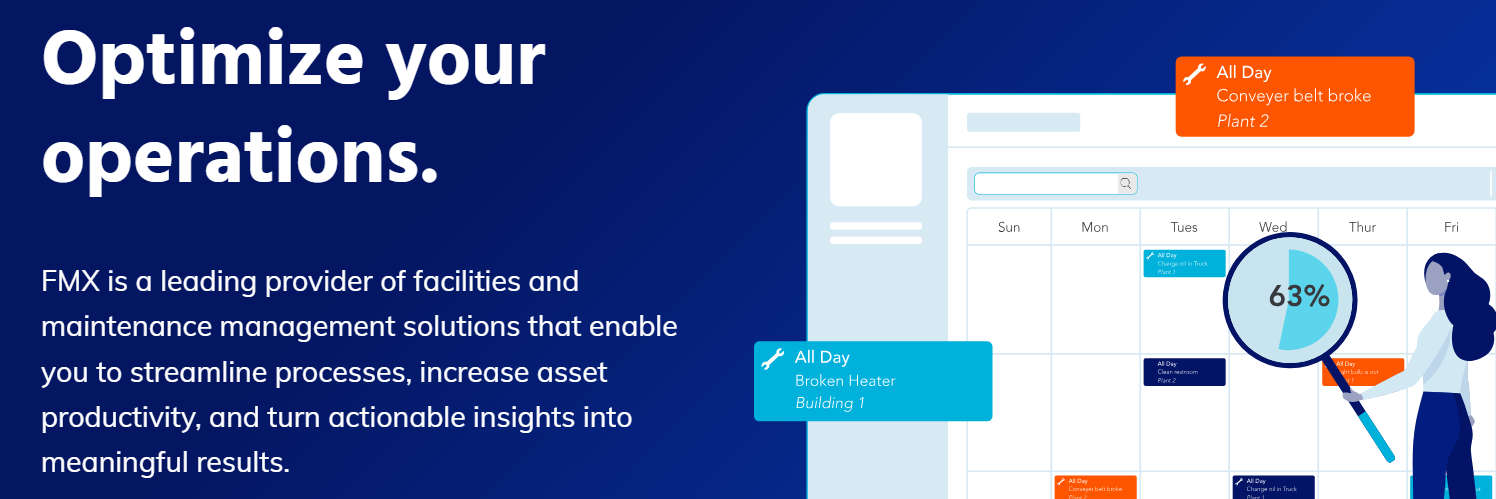
FMX offers a comprehensive facilities management platform, revolutionizing operations across industries. With robust features for asset tracking, vendor management, and mobile accessibility, FMX drives efficiency, reduces costs, and optimizes facility performance.
Key features:
- Asset lifecycle management: Tracks assets through their whole lifecycle.
- Document management: Stores and manages facilities management documentation.
- Work order creation: Creates work orders for assets and maintenance.
- Barcoding: Creates barcodes for more thorough asset management.
Pros:
- Provides training videos.
- Suitable for different industries.
- Quick and easy implementation of the software.
- Users have praised its customer support.
Cons:
- Searching for past comments is difficult.
Pricing: FMX pricing request.
Prodsmart

Prodsmart modernizes manufacturing operations with its intuitive platform, empowering businesses to digitize production processes and optimize efficiency. Through real-time data collection, analysis, and shop floor control, Prodsmart drives smarter decision-making, reduces waste, and fosters agile and responsive manufacturing practices across industries.
Key features:
- Real-time shop floor data: Collects and analyzes data instantly.
- Production tracking: Monitors production progress in real-time.
- Inventory management: Tracks inventory levels and movement.
- Quality control: Ensures product quality through checks and measures.
- Cost tracking: Tracks costs associated with production.
Pros:
- Efficiently plans and schedules production tasks.
- Uses barcodes for inventory and production tracking.
- Tracks and manages production batches.
- Automates manufacturing processes and tasks.
Cons:
- You have to sign up for the free trial to get pricing information.
- It has occasional issues with stability.
Pricing: Prodsmart free trial.
Quickbase

Quickbase provides adaptable tools to monitor, analyze, and optimize energy consumption. With customizable applications, it tracks usage patterns, automates data collection, and facilitates collaboration. Its versatile platform enables tailored solutions, empowering businesses to manage and enhance energy efficiency, driving sustainability initiatives effectively.
Key features:
- Custom app building: Create tailored applications without coding knowledge.
- Workflow automation: Streamline processes and automate tasks.
- Data integration: Connects with various sources for seamless data exchange.
- Form building: Design and deploy custom data entry forms.
- Task management: Track tasks, deadlines, and progress within apps.
Pros:
- Allows integration and customization with APIs for extended functionality.
- Assign roles and permissions for data access.
- Facilitate teamwork and communication within apps.
- It is completely customizable to specific energy management needs.
Cons:
- Requires time and expertise to build a functioning app.
Pricing: Quickbase pricing page.
Skedda

Skedda simplifies space management, offering an intuitive platform for booking and managing spaces. It streamlines scheduling for venues, rooms, and facilities, enabling seamless bookings and optimizing resource utilization. With its user-friendly interface, Skedda fosters efficient space management, facilitating hassle-free reservations for diverse organizational needs.
Key features:
- Online booking: Enables users to book spaces online.
- Venue management: Manages multiple venues or locations.
- Room reservation: Books rooms or spaces within venues.
- Resource allocation: Efficiently allocates resources for bookings.
- Custom booking policies: Customizes booking rules and policies.
Pros:
- Integrates payment processing for bookings.
- Tailors booking forms to specific needs.
- Provides support for multiple languages.
- Manages waitlists for fully booked spaces.
Cons:
- Customizations take time to set up.
- Customer support isn’t very responsive.
Pricing: Skedda pricing page.
ServiceNow Facility Management

ServiceNow Facility Management optimizes facility operations through its robust platform, offering streamlined solutions for maintenance, space utilization, and resource management. With its user-friendly interface and automation capabilities, it enhances workplace efficiency, elevates service delivery, and ensures seamless facilities management across diverse industries.
Key features:
- Facility security: Monitoring and managing security measures within facilities.
- Energy management: Optimizing energy consumption and efficiency.
- Facility compliance: Ensuring compliance with regulations and standards.
- Document management: Storing and managing facility-related documents.
- Workflow automation: Automating processes and tasks for efficiency.
Pros:
- Allocates resources for tasks and projects.
- Optimizes space allocation and utilization.
- Offers a catalog of services available within facilities.
- Manages relationships with service providers.
Cons:
- The reporting features aren’t intuitive.
- Users have reported poor value for money.
Pricing: ServiceNow Facility Management sales contact.
Nexudus

Nexudus modernizes coworking space management, offering an innovative platform for streamlined operations. It empowers coworking spaces to manage memberships, bookings, and resources efficiently. With its user-friendly interface and versatile solutions, Nexudus enhances member experiences, optimizes space utilization, and fosters vibrant coworking communities.
Key features:
- Membership management: Tracks and manages coworking space memberships.
- Booking and reservations: Allows users to book spaces or resources.
- Billing and invoicing: Manages billing and invoicing for memberships and services.
- CRM integration: Integrates with Customer Relationship Management tools.
- Visitor management: Manages guest or visitor access to spaces.
Pros:
- Accepts online payments for memberships or services.
- Allows customization of the platform’s appearance.
- Generates reports on space usage and memberships.
- Customizes and configures workspace settings.
Cons:
- You have to contact them to receive pricing information.
Pricing: Nexudus pricing request.
iLab Core Facility Management

iLab Core Facility Management simplifies scientific resource management, offering an intuitive platform for research facilities. It streamlines equipment scheduling, service requests, and billing, enhancing scientific collaboration and productivity. With its user-friendly interface and robust solutions, iLab Core Facility Management optimizes resource utilization and fosters efficient scientific operations.
Key features:
- Equipment reservation: Allows booking and scheduling of research equipment.
- Service request management: Manages requests for facility services or assistance.
- Billing and invoicing: Handles billing and invoicing for facility usage or services.
- Usage tracking: Tracks and monitors equipment or resource usage.
- User permissions: Sets different access levels for users or groups.
Pros:
- Tailors forms for specific facility requests or bookings.
- Ensures compliance with facility regulations or standards.
- Organizes and manages facility-related events.
- Sends reminders or updates to users.
Cons:
- They do not offer a free plan or a free trial.
- The UI isn’t very well-designed.
Pricing: iLab Core Facility Management pricing request available on landing page.
Archibus

Archibus transforms facilities management with its comprehensive platform, optimizing space utilization, and streamlining operations. Offering solutions for real estate, maintenance, and workplace management, it enhances efficiency and reduces costs. With a user-friendly interface and robust functionalities, Archibus drives productivity and ensures seamless facility operations.
Key features:
- Real estate management: Manages property and lease information.
- Occupancy planning: Plans and manages workplace occupancy.
- Reservations and services: Handles room reservations and service requests.
- Move management: Manages office moves and relocations.
- Environmental sustainability: Monitors and manages sustainability initiatives.
Pros:
- Manages construction or renovation projects.
- Monitors and optimizes energy consumption.
- Handles budgeting and cost tracking.
- Manages facility security measures and access.
Cons:
- Integrations don’t work very well.
- You have to book a demo to get pricing information.
Pricing: Archibus demo request.
OfficeSpace Software

OfficeSpace Software offers an intuitive platform for workplace management. It optimizes space utilization, streamlines moves, and fosters collaboration. It enhances workplace efficiency, driving productivity, and facilitating a dynamic and engaging work environment.
Key features:
- Space planning: Optimizes space allocation and floor planning.
- Move management: Organizes and manages office moves and relocations.
- Desk booking: Allows employees to book desks or workspaces.
- Floor maps and visuals: Visualizes office layouts and space utilization.
- Room reservations: Books meeting rooms or shared spaces.
Pros:
- Provides a directory of employees and locations.
- Submits and tracks office maintenance tasks.
- Organizes and visualizes seating arrangements.
- Monitors and optimizes space utilization.
Cons:
- Upgrading plans takes reorganization of all data.
- It sometimes misidentifies users’ locations.
Pricing: OfficeSpace Software demo request.
What is facilities management software?
Facilities management software is a comprehensive digital solution that streamlines the management of facilities, buildings, and assets.
This software provides a centralized platform for tracking and organizing various aspects of facility management, including maintenance, space utilization, equipment tracking, reducing maintenance costs, and more.
Facility management software is a powerful tool for organizations looking to streamline their facility management processes and improve the overall efficiency and effectiveness of their operations.
By centralizing all facility management tasks and data in one computerized maintenance management software, these tools can help organizations achieve greater control, visibility, and decision-making capabilities within their facilities.
Benefits of facilities management software
Facilities management software offers numerous benefits for organizations looking to streamline their operations and improve efficiency. Some of the key benefits include:
Centralized maintenance management
Facility management systems allow organizations to centralize their maintenance management processes, making it easier to track work orders, schedule preventive maintenance, and manage equipment and assets.
Improved resource utilization
By having a clear view of facility utilization and occupancy, organizations can better allocate resources and space, leading to cost savings and improved operational efficiency.
Enhanced compliance and safety
Facility management solutions help organizations ensure that they comply with industry regulations and safety standards by enabling them to track and manage safety procedures, inspections of physical spaces, and certifications.
Better asset management
Facilities management software provides a comprehensive view of an organization’s physical assets, allowing for better tracking, maintenance, and life cycle management.
Increased productivity
By automating routine tasks, providing real-time visibility into operations, and streamlining communication and workflow processes, facilities management software can significantly increase productivity and reduce downtime.
Cost savings
With better resource utilization, improved asset management, and increased productivity, facilities management software ultimately leads to cost savings for organizations.
Key features of facilities management software
Facilities management software offers a wide range of features designed to streamline and improve the management of facilities and assets. Key features of facilities management software include:
Asset tracking and management
The software allows users to easily track and manage all types of assets, including equipment, furniture, and facilities.
Maintenance scheduling
Facility managers can schedule and track maintenance tasks, such as inspections, repairs, and servicing, ensuring that facilities are well-maintained and compliant with regulations.
Work order management
Computerized maintenance management systems allow facility managers to create, assign, and track work orders, streamlining the process of managing maintenance and repair tasks.
Space management
Facilities management software enables users to effectively manage and optimize space usage, including office layouts, seating arrangements, and utilization of facilities.
Energy management
The software provides tools for monitoring and optimizing energy usage within facilities, helping to reduce costs and carbon footprint.
Reporting and analytics
Facilities management software offers robust reporting and analytics capabilities, providing valuable insights into facility performance and maintenance needs.
Integration with other systems
The software can seamlessly integrate with other systems, such as accounting, procurement, and building automation systems, enabling a more holistic approach to facilities management.







 Workflows
Workflows Projects
Projects Data Sets
Data Sets Forms
Forms Pages
Pages Automations
Automations Analytics
Analytics Apps
Apps Integrations
Integrations
 Property management
Property management
 Human resources
Human resources
 Customer management
Customer management
 Information technology
Information technology


